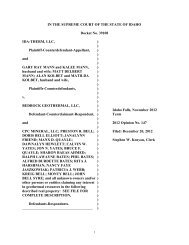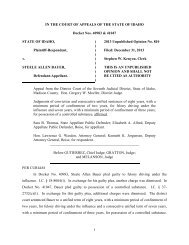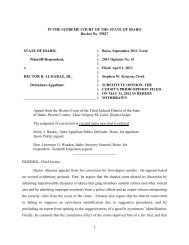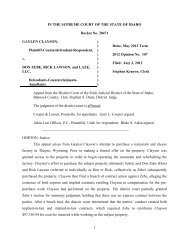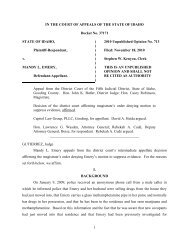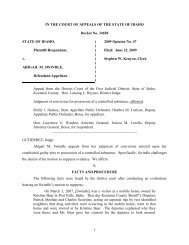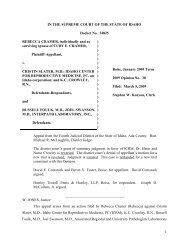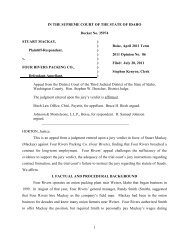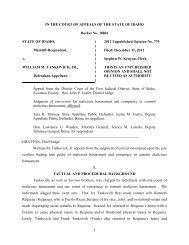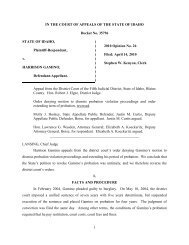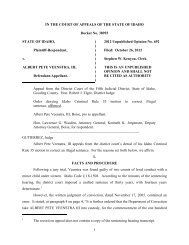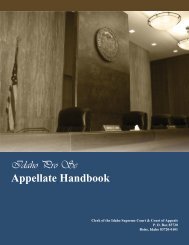David and Shirley Fuller v. Dave Callister - Idaho State Judiciary
David and Shirley Fuller v. Dave Callister - Idaho State Judiciary
David and Shirley Fuller v. Dave Callister - Idaho State Judiciary
Create successful ePaper yourself
Turn your PDF publications into a flip-book with our unique Google optimized e-Paper software.
IN THE SUPREME COURT OF THE STATE OF IDAHO<br />
Docket No. 37035<br />
DAVID <strong>and</strong> SHIRLEY FULLER, a married )<br />
couple<br />
)<br />
)<br />
Plaintiffs-Appellants-Cross Respondents,<br />
)<br />
)<br />
v.<br />
)<br />
)<br />
Boise, April 2011 Term<br />
) 2011 Opinion No. 51<br />
DAVE CALLISTER, an individual<br />
)<br />
CONFLUENCE MANAGEMENT, LLC, an<br />
<strong>Idaho</strong> limited liability company, <strong>and</strong><br />
LIBERTY PARTNERS, INC., an <strong>Idaho</strong><br />
corporation,<br />
)<br />
)<br />
)<br />
)<br />
)<br />
)<br />
Filed: May 6, 2011<br />
Stephen W. Kenyon, Clerk<br />
Defendants-Respondents-Cross<br />
)<br />
Appellants.<br />
)<br />
Appeal from the District Court of the Fourth Judicial District, <strong>State</strong> of <strong>Idaho</strong>, Ada<br />
County. Hon. Ronald J. Wilper, District Judge.<br />
District court order granting summary judgment, vacated.<br />
Davison, Copple & Copple, Boise, for appellants. Edward J. Guerricabeitia<br />
argued.<br />
Michael R. Jones, PLLC., Boise, for respondents. Michael R. Jones argued.<br />
__________________________________<br />
BURDICK, Justice<br />
This case comes before this Court on appeal from a grant of summary judgment in favor<br />
of <strong>David</strong> <strong>Callister</strong>, Confluence Management, LLC (“CM”) <strong>and</strong> Liberty Partners, Inc. (“LP”)<br />
(collectively, “Respondents”). On appeal <strong>David</strong> <strong>Fuller</strong> <strong>and</strong> <strong>Shirley</strong> <strong>Fuller</strong> (the <strong>Fuller</strong>s) argue that<br />
the district court erred, as a matter of law, in finding that: (1) the doctrine of merger prevented<br />
the <strong>Fuller</strong>s from enforcing an addendum to a purchase <strong>and</strong> sale agreement, where there had been<br />
a subsequent warranty deed conveying the property that was the subject of the purchase <strong>and</strong> sale<br />
agreement; (2) an assignment of all rights under the purchase <strong>and</strong> sale agreement from CM to<br />
LP, which the <strong>Fuller</strong>s consented to, relieved CM of all obligations or liabilities arising under that<br />
1
purchase <strong>and</strong> sale agreement; <strong>and</strong> (3) <strong>David</strong> <strong>Callister</strong>, as an individual, should be dismissed from<br />
the lawsuit as it was never alleged that he acted outside of his capacity as a corporate<br />
representative (where this issue was raised by the court sua sponte) 1 . Respondents cross-appeal,<br />
arguing that the district court erred in finding that Respondents were not entitled to attorney fees<br />
under I.C. § 12-120(3).<br />
I. FACTUAL AND PROCEDURAL BACKGROUND<br />
On September 20, 2005, CM entered into a Commercial/Investment Real Estate Purchase<br />
<strong>and</strong> Sale Agreement (“Purchase Agreement”) with the <strong>Fuller</strong>s, to acquire approximately 12.73<br />
acres of property adjacent to Ten Mile Road in Meridian, <strong>Idaho</strong>. At the time the Purchase<br />
Agreement was entered into Ada County Highway District (ACHD) was attempting to acquire<br />
part of the property for a right-of-way in order to exp<strong>and</strong> Ten Mile Road. On September 20,<br />
2005, after entering into the Purchase Agreement, the <strong>Fuller</strong>s <strong>and</strong> CM executed an addendum to<br />
the Purchase Agreement (“Addendum #1”) wherein CM agreed that it would deed over a portion<br />
of the property to ACHD <strong>and</strong> transfer the proceeds of such conveyance to the <strong>Fuller</strong>s. Under<br />
Addendum #1 the <strong>Fuller</strong>s retained the right to negotiate the purchase price with ACHD.<br />
On September 22, 2005, CM assigned the Purchase Agreement to LP, with the consent of<br />
the <strong>Fuller</strong>s. On the same day, the <strong>Fuller</strong>s executed a warranty deed conveying the property to<br />
LP; the warranty deed contained no mention of an anticipated condemnation or of Addendum #1.<br />
On August 10, 2006, LP entered into a Sale <strong>and</strong> Purchase Agreement with ACHD, <strong>and</strong> issued a<br />
warranty deed conveying approximately 1.43 acres of the property purchased from the <strong>Fuller</strong>s to<br />
ACHD. ACHD paid $83,921 for this property. The <strong>Fuller</strong>s requested that LP turn these funds<br />
over to the <strong>Fuller</strong>s pursuant to Addendum #1 of the Purchase Agreement, but LP refused.<br />
On October 21, 2008, the <strong>Fuller</strong>s filed suit against CM, LP <strong>and</strong> <strong>Callister</strong>, alleging, inter<br />
alia, that CM <strong>and</strong> <strong>Callister</strong> breached the Purchase Agreement. On June 23, 2009, the <strong>Fuller</strong>s<br />
brought a Motion for Partial Summary Judgment, <strong>and</strong> after both parties briefed the issues raised<br />
in that motion, oral argument was held on July 20, 2009. On August 24, 2009, the district court<br />
issued a Memor<strong>and</strong>um Decision <strong>and</strong> Order on Plaintiffs’ Motion for Partial Summary Judgment<br />
(“Memor<strong>and</strong>um Decision”) finding that: (1) the Purchase Agreement <strong>and</strong> Addendum #1 merged<br />
into the warranty deed <strong>and</strong> were no longer enforceable; (2) CM assigned all rights <strong>and</strong><br />
1 Although the <strong>Fuller</strong>s appealed this issue <strong>and</strong> argued it in their briefing before this Court, they subsequently waived<br />
the issue regarding the dismissal of <strong>Callister</strong> at oral argument. As such we shall not consider this issue.<br />
2
esponsibilities under the Purchase Agreement to LP <strong>and</strong> was no longer liable to the <strong>Fuller</strong>s; <strong>and</strong><br />
(3) <strong>Callister</strong> should be dismissed as a party.<br />
On September 28, 2009, the district court entered a Judgment consistent with the<br />
Memor<strong>and</strong>um Decision. The Judgment dismissed Count 1 of the <strong>Fuller</strong>s’ Amended Complaint<br />
(breach of contract claim against <strong>Callister</strong> <strong>and</strong> CM) on the basis that: (1) the district court found<br />
at summary judgment that the Purchase Agreement had been merged into the warranty deed; <strong>and</strong><br />
(2) the district court had found that the assignment of the Purchase Agreement from CM to LP<br />
relieved CM from any obligations under the Purchase Agreement. The Judgment dismissed<br />
Count 2 of the <strong>Fuller</strong>s’ Amended Complaint (unjust enrichment against LP) on the basis that it<br />
found there was an enforceable express contract. As the two causes of action dismissed by the<br />
district court were the only claims brought by the <strong>Fuller</strong>s, the court entered summary judgment in<br />
favor of Respondents on all claims. The <strong>Fuller</strong>s filed their notice of appeal on October 9, 2009.<br />
II. ISSUES ON APPEAL<br />
1. Whether the district court erred in finding that the Purchase Agreement <strong>and</strong> Addendum<br />
#1 had merged into the subsequently executed warranty deed <strong>and</strong> granting summary<br />
judgment on that issue.<br />
2. Whether the district court erred in finding that the assignment of the Purchase Agreement<br />
from CM to LP, with the consent of the <strong>Fuller</strong>s, removed all liabilities <strong>and</strong> obligations of<br />
CM pursuant to that agreement.<br />
3. Whether the district court erred in failing to grant attorney fees to Respondents under I.C.<br />
§ 12-120(3), having found that the gravamen of this legal action was not a commercial<br />
transaction, <strong>and</strong> whether Respondents are entitled to attorney fees on appeal on the same<br />
basis. Or whether, in the alternative, the <strong>Fuller</strong>s are entitled to attorney fees on appeal<br />
pursuant to I.A.R. 40 <strong>and</strong> 41 <strong>and</strong> paragraph 17 of the Purchase Agreement.<br />
III. STANDARD OF REVIEW<br />
As this Court noted in Castorena v. General Electric:<br />
When reviewing an order for summary judgment, the st<strong>and</strong>ard of review<br />
for this Court is the same st<strong>and</strong>ard as that used by the district court in ruling on<br />
the motion. Summary judgment is appropriate if “the pleadings, depositions, <strong>and</strong><br />
admissions on file, together with the affidavits, if any, show that there is no<br />
genuine issue as to any material fact <strong>and</strong> that the moving party is entitled to a<br />
judgment as a matter of law.” I.R.C.P. 56(c). Disputed facts should be construed<br />
in favor of the non-moving party, <strong>and</strong> all reasonable inferences that can be drawn<br />
from the record are to be drawn in favor of the non-moving party. This Court<br />
exercises free review over questions of law.<br />
149 <strong>Idaho</strong> 609, 613, 238 P.3d 209, 213 (2010) (quoting Vavold v. <strong>State</strong>, 148 <strong>Idaho</strong> 44, 45, 218<br />
P.3d 388, 389 (2009)).<br />
3
In Harwood v. Talbert, this Court wrote:<br />
The district court may grant summary judgment to a non-moving party<br />
even if the party has not filed its own motion with the court. A motion for<br />
summary judgment allows the court to rule on the issues placed before it as a<br />
matter of law; the moving party runs the risk that the court will find against it . . . .<br />
In instances where summary judgment is granted to the non-moving party,<br />
this Court liberally construes the record in favor of the party against whom<br />
summary judgment was entered. The party against whom the judgment will be<br />
entered must be given adequate notice <strong>and</strong> an opportunity to demonstrate why<br />
summary judgment should not be entered. It is also true that a district court may<br />
not decide an issue not raised in the moving party’s motion for summary<br />
judgment.<br />
136 <strong>Idaho</strong> 672, 677–78, 39 P.3d 612, 617–18 (2001) (internal citations omitted) (internal<br />
quotation omitted).<br />
IV. ANALYSIS<br />
The first issue is whether all provisions of the Purchase Agreement <strong>and</strong> Addendum #1<br />
were merged into the executed warranty deed. The second issue is whether the assignment of the<br />
Purchase Agreement from CM to LP relieved CM of all obligations thereunder. Third <strong>and</strong><br />
finally, whether Respondents should have been granted attorney fees before the district court,<br />
<strong>and</strong> whether either party is entitled to attorney fees on appeal. These issues shall be addressed in<br />
turn.<br />
A. The Purchase Agreement, <strong>and</strong> Addendum #1 thereto, were not merged into the executed<br />
warranty deed.<br />
The district court found that the Purchase Agreement <strong>and</strong> Addendum #1 merged into the<br />
subsequent warranty deed. The <strong>Fuller</strong>s argue that the reservation of ACHD right-of-way<br />
proceeds did not inhere to the same subject matter as the deed, <strong>and</strong> thus should not have been<br />
deemed merged.<br />
Addendum #1 to the Purchase Agreement is identified as a continuation of paragraph<br />
#10 2 of the Purchase Agreement (titled “Other Terms <strong>and</strong>/or Conditions”) <strong>and</strong> provides, inter<br />
alia:<br />
2 It is interesting to note that the “boilerplate language” in paragraph 10 of the Purchase Agreement states that “[t]his<br />
Agreement is made subject to the following special terms, considerations <strong>and</strong>/or contingencies which must be<br />
satisfied prior to closing”. If Addendum #1 is truly a continuation of paragraph 10 of the Purchase Agreement, it<br />
may be argued (as Respondents do argue) that the fact that the anticipated condemnation did not occur prior to<br />
closing effectively eliminates the continuing force of Addendum #1, regardless of merger. However, lines 32–35 of<br />
Addendum # 1 state that “[t]o the extent the terms of this ADDENDUM modify or conflict with any provisions of<br />
the Purchase <strong>and</strong> Sale Agreement including all prior Addendums <strong>and</strong> Counter Offers, these terms shall control. . . .<br />
4
3. Seller to receive any <strong>and</strong> all funds paid for road right of way including l<strong>and</strong>,<br />
l<strong>and</strong>scaping, fencing, sprinklers <strong>and</strong> temporary easements.<br />
Escrow instructions by the title company will cover the receipt <strong>and</strong> disbursement<br />
of the right of way funds. It is understood that buyer will be deeding the right of<br />
way to ACHD <strong>and</strong> that the seller, <strong>Dave</strong> <strong>and</strong> <strong>Shirley</strong> <strong>Fuller</strong> will receive all of said<br />
funds paid by ACHD. Said amount has not yet been determined <strong>and</strong> <strong>Dave</strong> <strong>and</strong><br />
<strong>Shirley</strong> <strong>Fuller</strong> retain the right to negotiate the amount with ACHD.<br />
The warranty deed executed by the <strong>Fuller</strong>s for the benefit of LP does not mention any reservation<br />
of right-of-way proceeds on behalf of the <strong>Fuller</strong>s. The district court found that, although the<br />
<strong>Fuller</strong>s argued that the relevant provision of Addendum #1 dealt only with money (the ACHD<br />
proceeds), “the term is the right of alienation of the property, the proceeds from the sale of a<br />
portion of the greater tract of real property to ACHD.” The court concluded that the right of<br />
alienation of property inhered to the same subject matter as the warranty deed <strong>and</strong> therefore<br />
merged.<br />
In Jolley v. <strong>Idaho</strong> Securities, Inc., the Jolleys agreed to trade their Lemhi County ranch<br />
<strong>and</strong> farming machinery for the Saratoga Hotel owned by <strong>Idaho</strong> Securities, Inc. 90 <strong>Idaho</strong> 373,<br />
378, 414 P.2d 879, 881 (1966). Pursuant to that agreement the parties stipulated who would be<br />
responsible for respective financial obligations existing on the properties (mortgages, tax liens,<br />
etc.), <strong>and</strong> it was agreed that each party would provide the other with an abstract of title to the<br />
respective properties. Id. at 378–79, 414 P.2d at 881–82. After this agreement was entered into,<br />
<strong>and</strong> the respective warranty deeds were executed <strong>and</strong> recorded, the Jolleys sought an abstract of<br />
title to the Saratoga Hotel, but that abstract was never delivered. Id. at 380, 414 P.2d at 882.<br />
The Jolleys subsequently failed to make payments on the mortgage on the Saratoga Hotel (which<br />
they were obligated to do under the agreement), the mortgage was foreclosed on, <strong>and</strong> a receiver<br />
took possession of the Saratoga Hotel. Id. The Jolleys filed suit against <strong>Idaho</strong> Securities, <strong>and</strong> a<br />
cross-claim was filed. Id. at 382, 414 P.2d at 884. The relevant issue on appeal before this Court<br />
was whether the agreement obligating each party to provide an abstract of title had been merged<br />
into the executed warranty deeds. Id.<br />
This Court provided the following explanation of the merger doctrine as it applies to a<br />
real estate purchase agreement <strong>and</strong> deed:<br />
Upon its execution by both parties, this agreement is made an integral part of the aforementioned Agreement.”<br />
Thus, to the extent the boilerplate language in paragraph 10 of the Purchase Agreement conflicts with Addendum<br />
#1, Addendum #1 is controlling. Furthermore, interpreting the Purchase Agreement as Respondents advocate would<br />
be contrary to the clear intent of the parties in adopting Addendum #1, as it was technically impossible for the buyer<br />
to transfer title to ACHD prior to closing, since the buyer would not yet have had title.<br />
5
[T]he acceptance of a deed to premises generally is considered as a merger of the<br />
agreements of an antecedent contract into the terms of the deed, <strong>and</strong> any claim for<br />
relief must be based on the covenants or agreements contained in the deed, not the<br />
covenants or agreements as contained in the prior agreement.<br />
Id. However, “[t]here is a generally recognized exception to the foregoing rule which exception<br />
relates to collateral stipulations of the contract, which are not incorporated in the deed.” Id. If a<br />
stipulation makes reference to title, possession, quantity or emblements of l<strong>and</strong> it will generally<br />
be considered to inhere to the subject matter of a warranty deed, <strong>and</strong> shall be considered merged<br />
<strong>and</strong>, thus, not a collateral stipulation. Id. at 383, 414 P.2d at 885. Although a grantee may<br />
accept a delivery of deed as a full performance of a prior contract, even where not all of the prior<br />
contract’s provisions were complied with, where those contractual provisions are collateral<br />
stipulations there is no presumption that any party intended to give up the benefit of such<br />
covenants, <strong>and</strong> this is a question of intent. Id. at 384, 414 P.2d at 885. Noting that an abstract of<br />
title does not relate to the title, possession, quantity or emblements of the l<strong>and</strong>, the Jolley Court<br />
concluded that the agreement to furnish an abstract was a collateral stipulation that was not<br />
merged through acceptance of the warranty deed. Id. at 385, 414 P.2d at 886.<br />
In Sells v. Robinson, the Sells (Seller) <strong>and</strong> Robinson (Buyer) entered into a Real Estate<br />
Purchase <strong>and</strong> Sale Agreement (“REPSA”), two relevant terms of which were: “[(1)] Seller to<br />
grant an all-inclusive easement on that portion of Sellers’ remaining l<strong>and</strong> located north <strong>and</strong> west<br />
of the northeast corner of parcel being sold. . . . [<strong>and</strong>; (2)] Timber rights on said easement are<br />
also included.” 141 <strong>Idaho</strong> 767, 770, 118 P.3d 99, 102 (2005) (emphasis in the original).<br />
Subsequently the Sells executed a warranty deed conveying the property to Robinson; the legal<br />
description for the warranty deed described the granted easement as follows:<br />
ALSO TOGETHER WITH an easement over <strong>and</strong> across a portion of the<br />
remaining l<strong>and</strong>s of the grantors lying North of the above described tract <strong>and</strong> West<br />
of the Northerly extension of the East line of said tract for the purpose of ingress,<br />
egress access to the existing creek, recreational <strong>and</strong> for removal of the timber<br />
located thereon.<br />
Id. (emphasis in the original). Robinson interpreted both the REPSA <strong>and</strong> warranty deed as<br />
granting him timber rights over the ten acres of the Sells’ property that was subject to the<br />
easement, <strong>and</strong> proceeded to log that property. Id. The Sells filed suit, arguing that the warranty<br />
deed only gave Robinson the right to remove trees from the access road, for the purpose of<br />
widening that road. Id. The relevant issue on appeal was whether the terms of the REPSA,<br />
related to the easement <strong>and</strong> timber rights, were merged into the executed warranty deed. This<br />
6
Court noted the general doctrine of merger—that “[w]here the right claimed under the contract<br />
would vary, change, or alter the agreement in the deed itself, or inheres in the very subject-<br />
matter with which the deed deals, a prior contract covering the same subject-matter cannot be<br />
shown as against the provisions of the deed.” Sells, 141 <strong>Idaho</strong> at 772, 118 P.3d at 104 (quoting<br />
Jolley, 90 <strong>Idaho</strong> at 382, 414 P.2d at 884) (alteration in the original) (emphasis added) (internal<br />
quotation marks omitted). In upholding the district court’s determination that the REPSA<br />
merged into the warranty deed, this Court found that “the terms of the REPSA Robinson seeks to<br />
enforce ‘inhere in the very subject-matter with which the deed deals’—the timber on the Sells’<br />
remaining property. The timber language in the REPSA does not constitute a collateral<br />
agreement relating to timber rights, independent of the terms of the deed.” Sells, 141 <strong>Idaho</strong> at<br />
772, 118 P.3d at 104.<br />
The <strong>Fuller</strong>s contend that there are several reasons why the district court erred in finding<br />
that the reservation of condemnation proceeds affected the right of alienation of property <strong>and</strong><br />
thus inhered to the same subject matter as the warranty deed. First, the Purchase Agreement was<br />
a personal agreement between the <strong>Fuller</strong>s <strong>and</strong> CM <strong>and</strong>/or its assigns, <strong>and</strong> if the property had been<br />
resold prior to the condemnation the <strong>Fuller</strong>s would have had no recourse. Second, property is<br />
always at risk of being condemned through eminent domain; this does not impact the right of<br />
alienation.<br />
Next the <strong>Fuller</strong>s argue that the parties necessarily intended for paragraph 3 of Addendum<br />
#1 to control after the execution of the warranty deed. Where it is clear that the parties did not<br />
intend for a provision in a real estate contract to merge with a subsequently executed warranty<br />
deed, that provision shall not be deemed merged. As stated in the American Law Reports:<br />
In all cases where there are stipulations in a preliminary contract for the<br />
sale of l<strong>and</strong>, of which the conveyance itself is not a performance, the true question<br />
must be whether the parties have intentionally surrendered those stipulations. The<br />
evidence of that intention may exist in or out of the deed. If plainly expressed in<br />
the very terms of the deed, it will be decisive. If not so expressed, the question is<br />
open to other evidence; <strong>and</strong> in the absence of any proof on the subject there is no<br />
presumption that either party, in giving or accepting a conveyance, intended to<br />
give up the benefit of covenants of which the conveyance was not a performance<br />
or satisfaction. . . . It is clear that the rule of merger does not apply where the<br />
plain intent of the parties is that a covenant in a contract should not be merged in<br />
the subsequently executed deed.<br />
A.G. Shepard, Annotation, Deed as Superseding, or Merging, Provisions of Antecedent Contract<br />
Imposing Obligations Upon the Vendor, 84 A.L.R. 1008 (1933). By the very nature of the<br />
7
obligation established in Addendum #1, it is clear that the parties expected that provision to<br />
continue in effect after the execution of the warranty deed. Addendum #1 requires that the buyer<br />
deed over a right-of-way to ACHD. If the transfer of the right-of-way was expected to occur<br />
prior to the buyer’s acquisition of the property the buyer would not need to be involved in the<br />
transfer of deed for that right-of-way. Where the relevant conditions of a contract could not have<br />
been performed prior to execution of the warranty deed, merger is inappropriate. See id.<br />
(“[W]here a deed constitutes only part performance of an executory contract for the conveyance<br />
of l<strong>and</strong>, leaving other matters for future performance, it does not constitute the entire contract,<br />
<strong>and</strong> stipulations as to future matters are not merged therein.”). See also Christiansen v.<br />
Intermountain Ass’n of Credit Men, 46 <strong>Idaho</strong> 394, 398, 267 P. 1074, 1075 (1928) (“Where the<br />
covenants in the contract do not relate to the conveyance, but are collateral to <strong>and</strong> independent of<br />
the conveyance, they are not merged in the deed, in so far as the deed is only a part performance<br />
of the contract.”).<br />
Finally the <strong>Fuller</strong>s argue that the reservation of proceeds was collateral <strong>and</strong> independent<br />
of the conveyance of the deed as it dealt only with money. The reservation of the potential<br />
condemnation proceeds was part of the consideration for the property, <strong>and</strong> the provision should<br />
properly be viewed as a portion of the purchase price. The <strong>Fuller</strong>s cite to the case of McGovern<br />
Builders, Inc. v. Davis, for the proposition that terms pertaining to the consideration to be paid<br />
for a real estate transaction are not merged into a subsequently executed deed. 468 N.E.2d 90,<br />
92 (Ohio Ct. App. 1983) (“[W]ritten agreement between the vendor <strong>and</strong> vendee for the sale,<br />
purchase <strong>and</strong> conveyance of l<strong>and</strong> is not executed by, <strong>and</strong> merged in the deed, as to the<br />
stipulations of the vendee therein concerning the consideration . . . <strong>and</strong> such written agreement is<br />
competent evidence to show the actual consideration.” (quoting Conklin v. Hancock, 66 N.E.<br />
518, 518 (Ohio 1903))).<br />
The district court erred in finding that paragraph 3 of Addendum #1 implicated the<br />
alienation of property. We find nothing in the provision that suggests that CM or its assign could<br />
not freely reconvey that property. The provision was thus personal to the parties involved.<br />
Based on the language of Addendum #1 <strong>and</strong> the clear intent of the parties that the condition<br />
expressed in paragraph 3 would occur after the execution of the warranty deed, as well as the fact<br />
that the reservation of condemnation proceeds is properly viewed as part of the consideration for<br />
the sale, we find that the doctrine of merger does not apply here.<br />
8
B. The district court erred in finding that the assignment of the Purchase Agreement from<br />
CM to LP, with the consent of the <strong>Fuller</strong>s, removed all of CM’s liabilities <strong>and</strong> obligations<br />
under the Purchase Agreement.<br />
The <strong>Fuller</strong>s argue that the district court erred in finding that the assignment of the<br />
Purchase Agreement from CM to LP entirely relieved CM of all obligations <strong>and</strong> liabilities under<br />
the Purchase Agreement.<br />
The district court cited only one case in support of its ruling on this issue, quoting the<br />
following from Van Berkem v. Mountain Home Development Co.: “The general rule would seem<br />
to be that where a contract is assignable the assignee acquires all the rights of the assignor <strong>and</strong><br />
takes the contract subject to all of the obligations of the assignor therein stipulated.” 132 <strong>Idaho</strong><br />
639, 641, 977 P.2d 901, 903 (Ct. App. 1999) (quoting Anderson v. Carrigan, 50 <strong>Idaho</strong> 550, 555,<br />
298 P. 673, 674 (1931)). Although true, the quoted statement st<strong>and</strong>s for the proposition that the<br />
assignee is subject to the obligations that the assignor initially assumed, not that the assignment<br />
relieves the assignor of those obligations.<br />
American Jurisprudence makes the following distinction between assignments <strong>and</strong> other<br />
transfers:<br />
Not every transfer of an interest is an assignment. An assignment is a<br />
voluntary act, unlike a court order directing an involuntary transfer of property,<br />
interests or rights. While an assignment is a formal transfer of property or<br />
property rights, “subrogation” is an equitable remedy in which one steps into the<br />
place of another <strong>and</strong> takes over the right to a claim for monetary damages to the<br />
extent that the other could have asserted it. A “novation” is the substitution of a<br />
new contract for an existing one. A novation differs from an assignment because<br />
it requires the assent of all parties, while an assignment generally requires neither<br />
the knowledge nor the assent of the obligor, <strong>and</strong> because an assignment cannot<br />
change the obligor’s performance. An assignment is not a debt; it is a full<br />
payment for something now, even though receipt of part of the value may occur in<br />
the future. An assignment is a formal transfer of property or property rights from<br />
one to another, while a waiver is the intentional relinquishment of a known right.<br />
6 Am.Jur.2d Assignments § 2 (2010) (footnotes omitted). The key distinction between an<br />
assignment <strong>and</strong> a novation is further elucidated in the following observation found in 58<br />
Am.Jur.2d Novation § 2 (2010):<br />
A party to a contract may not assign an obligation so as to avoid liability<br />
on the contract <strong>and</strong> shift liability to the assignee, unless the assignee assumes the<br />
obligation of the assignor with the consent of the other party to the contract <strong>and</strong><br />
the latter releases the assignor from further liability; in such case there is a<br />
novation. “Assumption” <strong>and</strong> “substitution” do not mean the same thing; although<br />
the latter term may strongly imply an intent to release the old debtor upon the new<br />
9
debtor’s involvement, the former term carries no such implication, that is,<br />
substitution connotes assumption plus release, but assumption does not<br />
necessarily imply release.<br />
(Emphasis added) (footnotes omitted). See also First Nat’l Bank in Evanston v. Sims, 78 <strong>Idaho</strong><br />
286, 290, 301 P.2d 1103, 1105 (1956) (“Novation requires the assent of all the parties. . . . Mere<br />
knowledge <strong>and</strong> consent of the creditor that a third party assume the debt will not release the<br />
original debtor. It must appear that the creditor agreed to release the original debtor.”).<br />
The transfer of interest at issue here took place in the Addendum to the Purchase<br />
Agreement executed September 20, 2005, which states, in full: “The undersigned sellers <strong>and</strong><br />
buyers agree to the following: 1. The buyers of said property will be assigned to vest as Liberty<br />
Partners Inc. All other terms <strong>and</strong> conditions shall remain the same.” This assignment does not<br />
purport to release CM of its obligations under the Purchase Agreement; there is no basis to<br />
believe that the <strong>Fuller</strong>s intended for the addendum to constitute a novation.<br />
Respondents argue that, even if CM remains liable under the Purchase Agreement, there<br />
are still conditions precedent to CM’s liability under paragraph 3 of Addendum #1 that were not<br />
satisfied. However, this is beyond the scope of the appeal. The issue before this Court is<br />
whether the district court erred in granting summary judgment to Respondents, in part based on<br />
the finding that the assignment of the Purchase Agreement to LP removed all obligations that<br />
CM had under the Purchase Agreement, not whether CM breached the Purchase Agreement. We<br />
find that the district court erred as a matter of law in granting summary judgment to Respondents<br />
on the issue of novation, as there was no clear acceptance of a novation by the <strong>Fuller</strong>s. The issue<br />
of whether CM is liable for a breach of the Purchase Agreement is an issue that will be<br />
determined at trial on rem<strong>and</strong>.<br />
C. Attorney fees.<br />
As we find that the district court erred in granting summary judgment in favor of<br />
Respondents, the question of whether the district court erred in denying Respondents attorney<br />
fees under I.C. § 12-120(3) is moot, as Respondents are no longer the prevailing party below.<br />
Likewise, Respondents are not the prevailing party on appeal.<br />
The <strong>Fuller</strong>s request attorney fees <strong>and</strong> costs on appeal pursuant to paragraph 17 of the<br />
Purchase Agreement. Paragraph 17 of the Purchase Agreement states: “ATTORNEY FEES: If<br />
either party initiates or defends any arbitration or legal action or proceedings which are in any<br />
way connected with this Agreement, the prevailing party shall be entitled to recover from the<br />
10
non-prevailing party reasonable costs <strong>and</strong> attorney’s fees, including such costs <strong>and</strong> fees on<br />
appeal.” The <strong>Fuller</strong>s did not bring a cause of action against LP pursuant to the Purchase<br />
Agreement; therefore, LP is not liable for any attorney fees or costs under the contract. The<br />
<strong>Fuller</strong>s have not appealed the district court’s dismissal of their claim of unjust enrichment against<br />
LP. At oral argument the <strong>Fuller</strong>s waived their appeal on the district court’s dismissal of <strong>Callister</strong><br />
as a party. The only party who may be liable for attorney fees is CM. However, because other<br />
defenses have not been addressed in the trial court, this Court cannot decide who ultimately will<br />
be the prevailing party for purposes of applicable attorney fees <strong>and</strong> costs. See Bagley v.<br />
Thomason, 149 <strong>Idaho</strong> 799, 804–05, 241 P.3d 972, 977–78 (2010) (noting that where attorney<br />
fees are authorized by statute or contract, but the prevailing party cannot be determined on an<br />
appeal before this Court, <strong>and</strong> the case is being rem<strong>and</strong>ed to the trial court, that court will be<br />
permitted to award the prevailing party attorney fees for the appeal). The trial court is to take the<br />
issue of attorney fees <strong>and</strong> costs for this appeal into consideration when it addresses all fees <strong>and</strong><br />
costs at the conclusion of the case.<br />
V. CONCLUSION<br />
We find that the district court erred in finding that Addendum #1 to the Purchase<br />
Agreement merged into the subsequently executed warranty deed, as to the issue of the<br />
reservation of the proceeds from the ACHD condemnation. Likewise, the district court erred in<br />
ruling that there was a valid novation relieving CM from its liability under that Purchase<br />
Agreement. We vacate the district court’s judgment <strong>and</strong> rem<strong>and</strong> for proceedings consistent with<br />
this opinion.<br />
Chief Justice EISMANN <strong>and</strong> Justices J. JONES, W. JONES <strong>and</strong> HORTON, CONCUR.<br />
11



